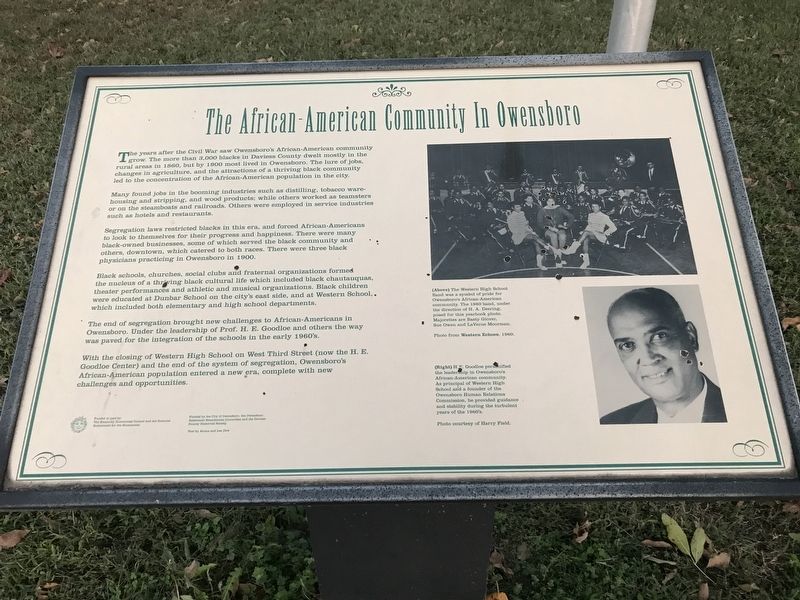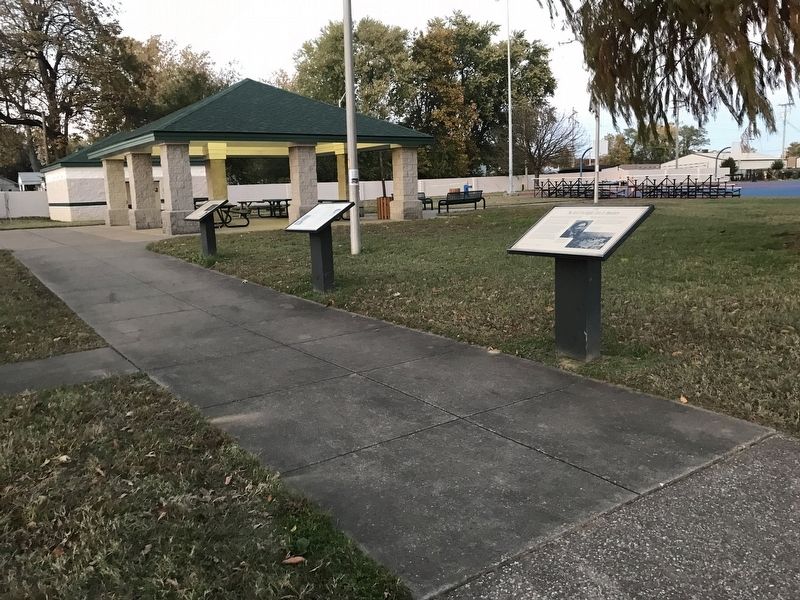Owensboro in Daviess County, Kentucky — The American South (East South Central)
The African American Community in Owensboro
Inscription.
The years after the Civil War saw Owensboro's African-American community grow. The more than 3,000 blacks in Daviess County dwelt mostly in the rural areas in 1860, but by 1900 most lived in Owensboro. The lure of jobs, changes in agriculture, and the attractions of a thriving black community led to the concentration of the African-American population in the city.
Many found jobs in the booming industries such as distilling, tobacco warehousing and stripping, and wood products; while others worked as teamsters or on the steamboats and railroads. Others were employed in service industries such as hotels and restaurants.
Segregation laws restricted blacks in this era, and forced African-Americans to look to themselves for their progress and happiness. There were many black-owned businesses, some of which served the black community and others, downtown, which catered to both races. There were three black physicians practicing in Owensboro in 1900.
Black schools, churches, social clubs and fraternal organizations formed the nucleus of a thriving black cultural life which included black chautauquas, theater performances and athletic and musical organizations. Black children were educated at Dunbar School on the city's east side, and at Western School, which included both elementary and high school departments.
The end of segregation brought new challenges to African-Americans in Owensboro. Under the leadership of Prof. H. E. Goodloe and others the way was paved for the integration of the schools in the early 1960's.
With the closing of Western High School on West Third Street (now the H. E. Goodloe Center) and the end of the system of segregation, Owensboro's African-American population entered a new era, complete with new challenges and opportunities.
Captions
Top: The Western High School Band was a symbol of pride for Owensboro's African-American community. The 1960 band, under the direction of H. A. Deering, posed for this yearbook photo. Majorettes are Basty Glover, Sue Owen and LaVerne Moorman. Photo from Western Echoes, 1960.
Bottom: H.E. Goodloe personified the leadership in Owensboro's African-American community. As principal of Western High School and a founder of the Owensboro Human Relations Commission, he provided guidance and stability during the turbulent years of the 1960's. Photo courtesy of Harry Field. Funded by the Text by Aloma and Lee Dew
Erected by City of Owensboro, Owensboro Settlement Bicentennial Committee and Daviess County Historical Society.
Topics. This historical marker is listed in these topic lists: African Americans
• Industry & Commerce • Railroads & Streetcars • Settlements & Settlers. A significant historical year for this entry is 1860.
Location. 37° 46.271′ N, 87° 7.415′ W. Marker is in Owensboro, Kentucky, in Daviess County. Marker can be reached from the intersection of West 5th Street and Cs-1186-30, on the right when traveling west. Marker is in Kendall-Perkins Park. Touch for map. Marker is at or near this postal address: 1201 W 5th St, Owensboro KY 42301, United States of America. Touch for directions.
Other nearby markers. At least 8 other markers are within walking distance of this marker. Born With a Purpose (a few steps from this marker); Two Early Civil Rights Cases in Owensboro (a few steps from this marker); Kendall-Perkins Park (a few steps from this marker); Dr. and Mrs. Clay E. Simpson, Sr. (approx. 0.2 miles away); Fourth Street Baptist Church (approx. 0.2 miles away); Moneta J. Sleet, Jr. / Pulitzer Prize Winner (approx. 0.3 miles away); Old Trinity Centre Parking Area (approx. 0.4 miles away); "Stirman's Folly" (approx. half a mile away). Touch for a list and map of all markers in Owensboro.
Credits. This page was last revised on November 5, 2020. It was originally submitted on November 5, 2020, by Duane and Tracy Marsteller of Murfreesboro, Tennessee. This page has been viewed 717 times since then and 121 times this year. Photos: 1, 2. submitted on November 5, 2020, by Duane and Tracy Marsteller of Murfreesboro, Tennessee. • Devry Becker Jones was the editor who published this page.

